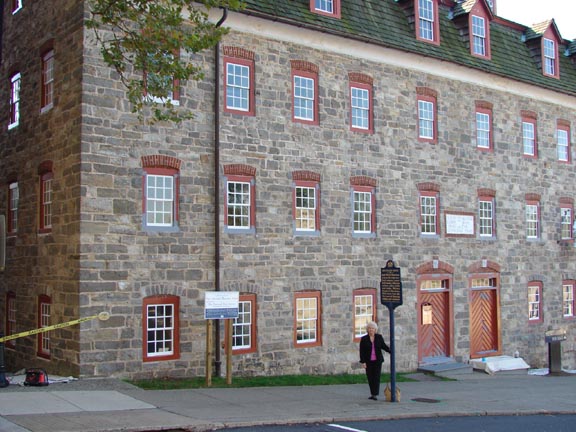|

That's me, Betty, in front of Brethren's house.
Believing that men and women had different religious needs, Count Nicholas Ludwig von Zinzendorf in 1736 organized the Moravian community around
groups of members known as "Choirs." Age, gender, and marital status determined what Choir a person would live in, and each group provided spiritual and social guidance
to its own. When children reached eighteen months of age, their parents sent them to the communal Nursery. At four they moved to either the Little Boys' or Little Girls'
Choir. At age twelve, they joined the Older Boys' or Older' Girls' Choir and at nineteen they moved into either the Single Brothers' or Single Sisters' Choir. Married
members became part of the Married People's Choir and when a spouse died, the surviving spouse joined the either Widows' or Widowers' Choir. The "Brethren's House"
housed the community's single men.
Faithful Moravians worshipped several times each day. In the Brethren House, Brothers awoke at 5 a.m. to the gentle sound of softly sung hymns. Breakfast, at
6 a.m., began with a benediction and the announcement of a particular word or phrase with a religious theme that the faithful were to contemplate throughout the day.
When they reconvened at noon for their main meal, they sang hymns both before and after dining. At 7 p.m. the entire congregation met for an hour of worship, which was
followed by a brief fifteen-minute prayer service among members meeting within their Choirs. At 9 p.m. all returned to pray together as a community. The day concluded at
10 p.m. with evening benediction in each Choir. While the faithful slept, each day a different person offered intercessions on the day's theme every hour around the
clock. From 10 at night to 5 in the morning, the night watch man sang hymns to mark each hour.
Credit: Library of Congress Life within the Brethren's House centered on work as well as worship. The Brothers began their chores promptly at 7 a.m. Soon after
their arrival in Pennsylvania the Moravians who settled Bethlehem created a "General Economy," in which everyone contributed their time and labor in exchange for food,
shelter, and the other necessities of life. In this communal economic system, each member of the Hausgemeine (house community, non-missionary) worked to support the
Pilgergemeine or missionaries, whom the Church sent to spread the Gospel among their European and Native American neighbors. The General Economy also provided a mutual
support network that helped the Moravians preserve their unique culture. While the Choirs only lasted until the 1760s, at which time Moravians decided to live again in
family units, their communally-based economic arrangement lasted for two more decades before the Church elders in Germany decided to replace it with privately owned
enterprises.
After the community made the transition to more family-centered living arrangements in the 1760s, only widows and single men continued to live in
Choirs. Economic necessity also forced changes. After the transition to private enterprise, the Brethren rented their lands to outsiders and old buildings assumed new
roles. The Brethren's House, for example, became a girls' school in 1815.
In the mid-nineteenth century, Bethlehem ceased to be a closed Moravian community. Already a bustling town and an early center of industry, Bethlehem
attracted non-Moravian families who were drawn by the promise of good jobs and the well-ordered lives of their Moravian neighbors. Tucked away in the rolling hills of
the Lehigh Valley, the Brethren's House stands today as a reminder of the unity and dedication with which the Moravians worked and worshipped in Bethlehem.
[Courtesy of Beverly Prior Smaby, The Transformation of Moravian Bethlehem (Philadelphia, PA: University of Pennsylvania Press, 1988).]
|